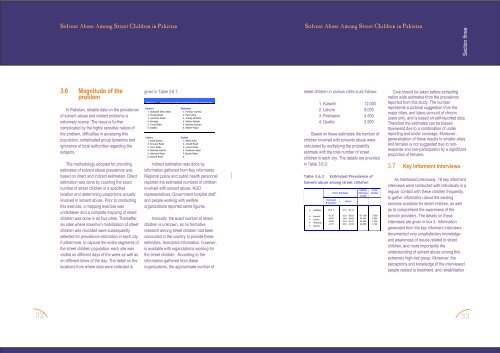solvent-abuse-pakistan
solvent-abuse-pakistan
solvent-abuse-pakistan
Create successful ePaper yourself
Turn your PDF publications into a flip-book with our unique Google optimized e-Paper software.
Section three<br />
3.6 Magnitude of the<br />
problem<br />
In Pakistan, reliable data on the prevalence<br />
of <strong>solvent</strong> <strong>abuse</strong> and related problems is<br />
extremely scarce. The issue is further<br />
complicated by the highly sensitive nature of<br />
the problem, difficulties in accessing this<br />
population, complicated group dynamics and<br />
ignorance of local authorities regarding the<br />
subjects.<br />
The methodology adopted for providing<br />
estimates of <strong>solvent</strong> <strong>abuse</strong> prevalence was<br />
based on direct and indirect estimation. Direct<br />
estimation was done by counting the exact<br />
number of street children in a specified<br />
location and determining proportions actually<br />
involved in <strong>solvent</strong> <strong>abuse</strong>. Prior to conducting<br />
this exercise, a mapping exercise was<br />
undertaken and a complete mapping of street<br />
children was done in all four cities. Thereafter,<br />
six sites where maximum mobilization of street<br />
children was recorded were subsequently<br />
selected for prevalence estimation in each city.<br />
Furthermore, to capture the entire segments of<br />
the street children population, each site was<br />
visited on different days of the week as well as<br />
on different times of the day. The detail on the<br />
locations from where data were collected is<br />
given in Table 3.6.1.<br />
Table 3.6.1<br />
Karachi<br />
1. Abdullah Shah Ghazi<br />
2. Hussainabad<br />
3. Jamshair Road<br />
4. Korangi<br />
5. Tariq Road<br />
6. Saddar<br />
Lahore<br />
1. Data Darbar<br />
2. Circular Road<br />
3. Larri Adda<br />
4. Railway Station<br />
5. Macleod Road<br />
6. Multan Road<br />
Study sites from where prevalence estimates are generated<br />
Peshawar<br />
1. Firdous Cinema<br />
2. Haji Camp<br />
3. Jhangi Mohalla<br />
4. Kabuly Bazaar<br />
5. Railway Station<br />
6. Khyber Road<br />
Quetta<br />
1. Habib Nala<br />
2. Jinnah Road<br />
3. Lower Karez<br />
4. Pushtoon abad<br />
5.Saryab Road<br />
6.<br />
Indirect estimation was done by<br />
information gathered from Key informants.<br />
Regional police and public health personnel<br />
reported the estimated numbers of children<br />
involved with <strong>solvent</strong> <strong>abuse</strong>. NGO<br />
representatives, Government hospital staff,<br />
and people working with welfare<br />
organizations reported same figures.<br />
Ironically, the exact number of street<br />
children is unknown, as no formative<br />
research among street children had been<br />
conducted in the country to provide these<br />
estimates. Anecdotal information, however,<br />
is available with organizations working for<br />
the street children. According to the<br />
information gathered from these<br />
organizations, the approximate number of<br />
34<br />
street children in various cities is as follows:<br />
1. Karachi 12,000<br />
2. Lahore 8,000<br />
3. Peshawar 4,500<br />
4. Quetta 2,500<br />
Based on these estimates the number of<br />
children involved with <strong>solvent</strong>s <strong>abuse</strong> were<br />
calculated by multiplying the probability<br />
estimate with the total number of street<br />
children in each city. The details are provided<br />
in Table 3.6.2:<br />
Table 3.6.2<br />
Estimated Prevalence of<br />
Solvent <strong>abuse</strong> among street children<br />
<br />
OVERALL<br />
Karachi<br />
Lahore<br />
Peshawar<br />
Quetta<br />
Estimated<br />
Prevalence<br />
39.6 %<br />
45.3%<br />
36.9%<br />
36.8%<br />
41.7%<br />
Direct Estimates<br />
95% CI<br />
33.1 – 46.1%<br />
32.0 – 58.6%<br />
24.0 – 49.8%<br />
23.9 – 49.7%<br />
28.5 – 54.9%<br />
Indirect<br />
Estimates<br />
(range)<br />
-<br />
50 - 60%<br />
30-35%<br />
25-30%<br />
40-50%<br />
Total<br />
Number<br />
-<br />
5,500<br />
2,900<br />
1,700<br />
1,100<br />
Care should be taken before extracting<br />
nation wide estimates from the prevalence<br />
reported from this study. The number<br />
represents a pictorial suggestion from the<br />
major cities, and takes account of chronic<br />
users only, and is based on self-reported data.<br />
Therefore the estimates can be biased<br />
downward due to a combination of under<br />
reporting and under coverage. Moreover,<br />
generalization of these results to smaller cities<br />
and females is not suggested due to nonresponse<br />
and non-participation by a significant<br />
proportion of females.<br />
3.7 Key Informant Interviews<br />
As mentioned previously, 18 key informant<br />
interviews were conducted with individuals in a<br />
regular contact with these children frequently,<br />
to gather information about the existing<br />
services available for street children, as well<br />
as to comprehend the awareness of the<br />
service providers. The details on these<br />
interviews are given in box 4. Information<br />
generated from the key informant interviews<br />
documented very unsatisfactory knowledge<br />
and awareness of issues related to street<br />
children, and more importantly the<br />
understanding of <strong>solvent</strong> <strong>abuse</strong> among this<br />
extremely high-risk group. Moreover, the<br />
perceptions and knowledge of the interviewed<br />
people related to treatment, and rehabilitation<br />
32<br />
33


